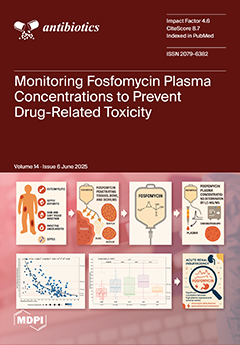Background/Objectives: The current need for new antibacterial compounds that target non-classical pathways is highlighted by the emergence of multidrug-resistant
Klebsiella pneumoniae. In the development of antibiotics, DNA adenine methyltransferase (Dam), a key regulator of bacterial gene expression and pathogenicity, is still underutilized. Epoxy-functionalized analogues of isatin derivatives have not been adequately investigated for their antibacterial activity, particularly as Dam inhibitors. In the pursuit of antimicrobial agents, this study synthesized an epoxy-functionalized isatin derivative (
L3) using a one-pot reaction. The compound was characterized using FT-IR, ¹H-NMR,
13C-NMR, HR-MS, and UV–Vis spectroscopy. Methods:
In silico evaluation performed by using ADMETlab3 and SwissADME. While molecular docking studies were achieved by AutoDock and Vina to find
L3’s interaction with potential antibacterial target (Dam protein in
K. pneumoniae). In addition, the antibacterial potential of
L3 was evaluated using minimum inhibitory concentration (MIC) assays against
Bacillus cereus,
Bacillus pumilus,
Escherichia coli, and
K. pneumoniae. Results: Among these,
L3 exhibited potential inhibitory activity against
K. pneumoniae, with a MIC value of 93.75 μg/mL.
In silico evaluations confirmed
L3’s favorable drug-like properties, including potential oral bioavailability, blood–brain barrier (BBB) permeability, and low plasma protein binding (PPB). The compound satisfied Lipinski’s and other drug-likeness rules as well as getting a quantitative estimate of drug-likeness (QED) score of 0.52. Here, a homology model of Dam protein in
K. pneumoniae was generated using the SWISS-MODEL server and validated using computational tools. Targeted docking analysis revealed that
L3 exhibited significant potential binding affinity against Dam protein, with binding energies of −6.4 kcal/mol and −4.85 kcal/mol, as determined by Vina and AutoDock, respectively. The associated inhibition constant was calculated as 280.35 µM. Further interaction analysis identified the formation of hydrogen bonds with TRP7 and PHE32, along with Van der Waals’ interactions involving GLY9, ASP51, and ASP179. Conclusions: These findings highlight
L3 as a promising scaffold for antimicrobial drug development, particularly in targeting Dam protein in
K. pneumoniae. Furthermore, the ADMET profiling and physicochemical properties of
L3 support its potential as a drug-like candidate.
Full article






